1 of 10




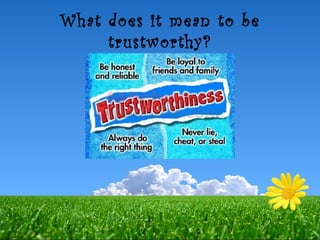
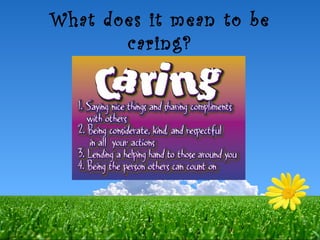

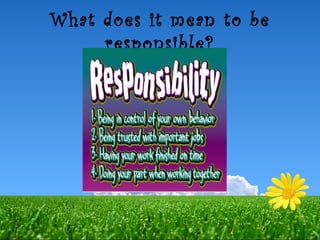
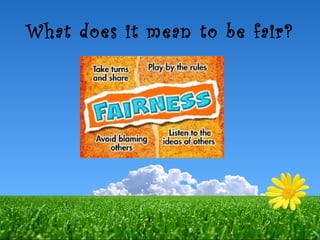
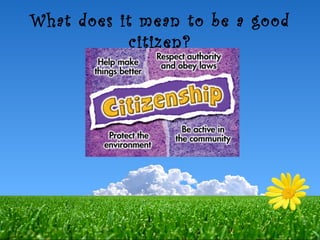
Ad
Recommended
Character Education
Character EducationLaTea Childs
╠²
The document outlines the six pillars of character: trustworthiness, respect, responsibility, fairness, caring, and citizenship. It provides definitions and examples for each pillar. Trustworthiness involves being honest, reliable, and loyal. Respect is about treating others well and being tolerant. Responsibility means doing what you are supposed to do and persevering. Fairness involves playing by the rules and being open-minded. Caring means being kind, compassionate, and helpful. Citizenship is about contributing to the community and protecting the environment.Character education (1)
Character education (1)Austin O'Connor
╠²
It is important for both parents and teachers to teach children positive character development through methods like character education programs in schools. Character education helps develop skills like ethics, manners, respect and responsibility. The document suggests ways to incorporate character education into classrooms, such as using a webquest to teach voting, having students create PSAs about bullying, podcasts about respect, and QR codes and posters with videos modeling proper manners. Both the classroom and parenting environment are crucial for enforcing core values in the next generation.Caring values assembly
Caring values assemblytinagage
╠²
The document discusses how the values for each month from September to December were positivity, independence, forgiveness, and caring. It emphasizes caring for others through words, actions, and caring for each other. It notes that not everyone is as fortunate as others and some will rely on food banks at Christmas. It provides links to videos about showing care and includes a song to listen to while thinking about how to show you care.Constitution Power Point
Constitution Power PointLaTea Childs
╠²
The document discusses the key principles of the US Constitution, including the federal system that divides powers between the national and state governments. It describes the three branches of government - the legislative, executive, and judicial branches - and their powers. It also explains the system of checks and balances between the branches to prevent any one from becoming too powerful. Finally, it mentions the Bill of Rights and how it guarantees certain individual freedoms and liberties.Trust and Trustworthiness
Trust and TrustworthinessJohn Fisher
╠²
The document discusses the importance of trust and trustworthiness. It defines trust as something earned through honest communication, predictable behavior, and mutual respect. It suggests exercises for identifying who and what you trust and the reasons for that trust. Building trust requires clear expectations, open reviews of problems, and never violating trust. Maintaining trust is important as first impressions and every interaction can impact it, and trust is difficult to regain once lost.Trustworthiness
TrustworthinessShawky Allam
╠²
Mr. Anderson's character development class focuses on the character traits of trustworthiness, loyalty, and integrity. The class defines these traits and provides examples. Trustworthiness involves being honest and reliable. Loyalty means promoting and protecting others. Integrity is behaving ethically in all situations. The class discusses the fable "The Blind Woman and the Physician" and questions about taking advantage of others.Real World Math (Packet for Home)
Real World Math (Packet for Home)mwinfield1
╠²
This document provides 3 real world math activities that can be done at home to support math instruction:
1) Grocery shopping - tasks like weighing produce and calculating costs, comparing unit prices, and estimating total bills.
2) Balancing a checkbook - recording checks, deposits, and transactions to calculate a running balance.
3) Calculating coupons and discounts - tasks like figuring out percent discounts on items.Math tricks poster
Math tricks postermwinfield1
╠²
To subtract integers, follow the "keep, change, change" method: keep the sign of the first number, change the subtraction sign to addition, and change the sign of the second number. This allows subtracting integers to be done as an addition problem.Basic Math Skills Pre-Assessment
Basic Math Skills Pre-Assessmentmwinfield1
╠²
This document contains an informal math assessment with three parts: computation, word problems, and content area skills. The computation section includes addition, subtraction, multiplication, and division problems. The word problems section involves underlining key words, choosing the correct operation, and solving. The content area skills section contains expression writing, multi-step word problems involving operations, unit pricing, and percent problems.Race to... Lesson
Race to... Lessonmwinfield1
╠²
This math lesson involves using dice to teach place value and multi-digit addition up to grades 6. Students will be divided into groups of 3-4, given different colored dice representing places values, and play a game trying to add numbers rolled on the dice to reach a target number first. As they play, students will record their rolls and totals on a game sheet. This allows the teacher to evaluate their understanding of place value and multi-digit addition.Technology in the math curriculum
Technology in the math curriculummwinfield1
╠²
IXL is an online resource that contains many math practice activities aligned to Common Core standards. Teachers can assign specific standards for students to practice, and students can also practice at home. Khan Academy provides hundreds of math tutorials from kindergarten through college, along with practice problems and hints. It is useful for homework help and for parents helping their children learn. Smart Exchange allows teachers to share and modify Smartboard lessons. Shared files can be customized for different classes. Smartboard activities benefit students with disabilities by enabling direct interaction. Math Goodies is an online notebook for students with built-in interactive practice problems. It contains visual examples and is suitable for students who have difficulty copying from the board.Dyscalculia
Dyscalculiamwinfield1
╠²
Dyscalculia is a condition that affects the ability to acquire arithmetical skills, causing difficulty understanding number concepts, grasping the value of numbers, and learning number facts and procedures. It can cause problems even if the individual gets the right answer through mechanical means without true understanding. There are warning signs from an early age and difficulties experienced by students with the condition in math class.Math test taking checklist
Math test taking checklistmwinfield1
╠²
This math test taking checklist provides students with steps to follow when taking a math test, including reading directions and questions carefully, determining what the question is asking, selecting a problem-solving strategy, showing all work, checking answers, and choosing the best answer for multiple choice or writing a complete response for other questions. The checklist aims to help students successfully complete math test problems by following an organized process.Multiplication strategies
Multiplication strategiesmwinfield1
╠²
This document provides an overview of multiplication fluency strategies including the partial products method, lattice method, and place value method. It also lists citations for additional resources on multiplication strategies, memorizing multiplication facts, algorithms and analysis, and multiplying multi-digit numbers.Strategies for solving math word problems
Strategies for solving math word problemsmwinfield1
╠²
This document discusses several different methods for solving math word problems:
- The Toolbox Method allows students to choose from multiple strategies to find the one that works best for them.
- The CUBES Method is well-suited for visual learners as it has them dissect and analyze the word problem.
- The STEPS Method provides students with a sequential structure to follow when solving word problems.
- The Step by Step Method also provides a step-by-step process and works well for logical, sequential thinkers.Study Memorization Skills
Study Memorization Skillsmwinfield1
╠²
This document provides educational resources including:
1. A mnemonic tool for long division with steps like "Divide, Multiply, Subtract, Bring Down, Repeat".
2. A song set to the tune of "My Buddy" to teach body parts like legs, toes, arms, fingers, head, chest, belly, and intestines.
3. A website for students to practice multiplication facts.Behavior observation notes template
Behavior observation notes templatemwinfield1
╠²
This document contains a behavior observation form completed by Mrs. Winfield-Corbett to record a student's behavior during a class. The form tracks behaviors like calling out without raising a hand, being out of their seat without permission, excessive talking, disrespect towards others, being off task, and noncompliance. It also includes space for comments on each behavior and questions about the student's preparedness, appearance, homework, and interactions.Behavior report
Behavior reportmwinfield1
╠²
This weekly progress report summarizes a student's behavior and academic performance for a specific week. It includes ratings of the student's behavior towards peers and authority as well as participation, cooperation, and following rules. Any academic or behavioral concerns are noted, and parents are asked to sign the report before returning it to the teacher. Space is provided for additional parent/teacher comments.Place value match game
Place value match gamemwinfield1
╠²
This document contains directions for two place value game cards created by Mrs. Winfield-Corbett. For each card, students will write digits in the correct place value spots as numbers are called out. After all digits are written, students raise their hands to read the number aloud to check their understanding of place value. The game aims to teach place value through an engaging activity with two similar cards at different difficulty levels.Cells Virtual Lab
Cells Virtual Labmwinfield1
╠²
This document provides directions for a virtual lab on animal and plant cells, asking students to label diagrams of each type of cell and color them according to a website showing cell structures in different colors. Students are asked to provide their name, date, teacher, and the website used for the virtual lab on labeling animal and plant cell diagrams.Cell Webquest Modified
Cell Webquest Modifiedmwinfield1
╠²
This document contains a series of tasks from a biology worksheet about cells. It includes questions about prokaryotic and eukaryotic cells, identifying cell structures like the cell membrane and nucleus in animal and plant cells, and levels of organization from cells to organ systems. The student is directed to various websites to view cell images and structures and answer related questions.Student Tool Kit for Research Papers
Student Tool Kit for Research Papersmwinfield1
╠²
This document provides templates for students to organize different types of writing assignments, including a research paper outline, time-order chart, persuasion map, four-square writing method, and describing wheel. The templates include sections for an introduction, body with subtopics, and conclusion for a research paper; boxes to list a topic, events, and details for a time-order chart; boxes for a goal, reasons, and facts/examples for a persuasion map; sections for a topic sentence and supportive sentences for the four-square writing method; and spokes to add describing words for a describing wheel.Technology in the classroom teaching in new creative ways
Technology in the classroom teaching in new creative waysmwinfield1
╠²
Math Fact Caf├® is a website that provides various resources to help students master basic math facts from 1st through 4th grade, including interactive flashcards, fact building sheets, and games. The flashcards can be used in the classroom as centers or projected for whole-class activities. The site also has premade worksheets and a worksheet generator for differentiating instruction. It is a useful tool for both classroom use and for parents to help students learn math facts at home.An overview of visual, auditory, and kinesthetic learners
An overview of visual, auditory, and kinesthetic learnersmwinfield1
╠²
This document provides an overview of the three main learning styles: visual, auditory, and kinesthetic. It defines each style and lists their key characteristics. For visual learners, it notes they prefer using images and seeing information written down. Auditory learners learn through listening and speaking. Kinesthetic learners learn best through physical activities and movement. The document concludes by emphasizing the importance of teachers using diverse strategies to engage different learning styles.7 creative classroom organization ideas
7 creative classroom organization ideasmwinfield1
╠²
This document provides 7 ideas for organizing a classroom: 1) Using desk caddies with supplies for each student to avoid disruptions. 2) Sorting bins to organize a teacher's desk and papers. 3) Sorting clips to help teaching assistants efficiently organize papers by category. 4) Make-up assignment bins so absent students can independently make up missed work. 5) Organizing the classroom closet with labeled shoe boxes. 6) Using a sign in/out chart with colored buttons or stones instead of paper to track students entering and leaving. 7) Attaching disposable tissue boxes to student desks for easy access during flu season.Top 10 benefits of peer assisted learning
Top 10 benefits of peer assisted learningmwinfield1
╠²
The document outlines 10 benefits of peer assisted learning. It notes that peer assisted learning helps students learn from each other while also contributing to others' learning, fostering interpersonal skills and content understanding. It also states that peer learning creates a trusting environment where students can support each other emotionally and academically during the learning process. Finally, the summary mentions that peer learning can help develop students' communication, creativity, problem solving and confidence.Lyddie cooperative learning vocabulary lesson
Lyddie cooperative learning vocabulary lessonmwinfield1
╠²
This document provides a summary of a 40-minute 7th grade English/Reading class focusing on the novel Lyddie. Students will use thinking strategies like THINK-PAIR-SHARE and peer teaching to complete a KWL chart on vocabulary terms from chapter 1 and create vocabulary review cards using the Frayer Model. The lesson objectives are for students to understand new vocabulary and consider how life may have been different during the Industrial Revolution.Lyddie think pair share lesson
Lyddie think pair share lessonmwinfield1
╠²
The 40-minute English/Reading class will focus on comparing a fictional portrayal of the Industrial Revolution to historical accounts. Students will listen to an excerpt from the novel Lyddie and view images of a Lowell Mill factory. They will then make predictions by completing an anticipation guide individually, discussing it in pairs, and sharing as a group to engage with essential questions about the hardships faced during this time period and how their lives might be different. The learning objective is for students to anticipate themes in Lyddie, and they will revisit their initial predictions after finishing the novel.Great Governors' Send-Off Quiz 2025 Prelims IIT KGP
Great Governors' Send-Off Quiz 2025 Prelims IIT KGPIIT Kharagpur Quiz Club
╠²
Prelims of the Great Governors' Send-Off Quiz 2025 hosted by the outgoing governors.
QMs: Aarushi, Aatir, Aditya, ArnavMore Related Content
More from mwinfield1 (20)
Basic Math Skills Pre-Assessment
Basic Math Skills Pre-Assessmentmwinfield1
╠²
This document contains an informal math assessment with three parts: computation, word problems, and content area skills. The computation section includes addition, subtraction, multiplication, and division problems. The word problems section involves underlining key words, choosing the correct operation, and solving. The content area skills section contains expression writing, multi-step word problems involving operations, unit pricing, and percent problems.Race to... Lesson
Race to... Lessonmwinfield1
╠²
This math lesson involves using dice to teach place value and multi-digit addition up to grades 6. Students will be divided into groups of 3-4, given different colored dice representing places values, and play a game trying to add numbers rolled on the dice to reach a target number first. As they play, students will record their rolls and totals on a game sheet. This allows the teacher to evaluate their understanding of place value and multi-digit addition.Technology in the math curriculum
Technology in the math curriculummwinfield1
╠²
IXL is an online resource that contains many math practice activities aligned to Common Core standards. Teachers can assign specific standards for students to practice, and students can also practice at home. Khan Academy provides hundreds of math tutorials from kindergarten through college, along with practice problems and hints. It is useful for homework help and for parents helping their children learn. Smart Exchange allows teachers to share and modify Smartboard lessons. Shared files can be customized for different classes. Smartboard activities benefit students with disabilities by enabling direct interaction. Math Goodies is an online notebook for students with built-in interactive practice problems. It contains visual examples and is suitable for students who have difficulty copying from the board.Dyscalculia
Dyscalculiamwinfield1
╠²
Dyscalculia is a condition that affects the ability to acquire arithmetical skills, causing difficulty understanding number concepts, grasping the value of numbers, and learning number facts and procedures. It can cause problems even if the individual gets the right answer through mechanical means without true understanding. There are warning signs from an early age and difficulties experienced by students with the condition in math class.Math test taking checklist
Math test taking checklistmwinfield1
╠²
This math test taking checklist provides students with steps to follow when taking a math test, including reading directions and questions carefully, determining what the question is asking, selecting a problem-solving strategy, showing all work, checking answers, and choosing the best answer for multiple choice or writing a complete response for other questions. The checklist aims to help students successfully complete math test problems by following an organized process.Multiplication strategies
Multiplication strategiesmwinfield1
╠²
This document provides an overview of multiplication fluency strategies including the partial products method, lattice method, and place value method. It also lists citations for additional resources on multiplication strategies, memorizing multiplication facts, algorithms and analysis, and multiplying multi-digit numbers.Strategies for solving math word problems
Strategies for solving math word problemsmwinfield1
╠²
This document discusses several different methods for solving math word problems:
- The Toolbox Method allows students to choose from multiple strategies to find the one that works best for them.
- The CUBES Method is well-suited for visual learners as it has them dissect and analyze the word problem.
- The STEPS Method provides students with a sequential structure to follow when solving word problems.
- The Step by Step Method also provides a step-by-step process and works well for logical, sequential thinkers.Study Memorization Skills
Study Memorization Skillsmwinfield1
╠²
This document provides educational resources including:
1. A mnemonic tool for long division with steps like "Divide, Multiply, Subtract, Bring Down, Repeat".
2. A song set to the tune of "My Buddy" to teach body parts like legs, toes, arms, fingers, head, chest, belly, and intestines.
3. A website for students to practice multiplication facts.Behavior observation notes template
Behavior observation notes templatemwinfield1
╠²
This document contains a behavior observation form completed by Mrs. Winfield-Corbett to record a student's behavior during a class. The form tracks behaviors like calling out without raising a hand, being out of their seat without permission, excessive talking, disrespect towards others, being off task, and noncompliance. It also includes space for comments on each behavior and questions about the student's preparedness, appearance, homework, and interactions.Behavior report
Behavior reportmwinfield1
╠²
This weekly progress report summarizes a student's behavior and academic performance for a specific week. It includes ratings of the student's behavior towards peers and authority as well as participation, cooperation, and following rules. Any academic or behavioral concerns are noted, and parents are asked to sign the report before returning it to the teacher. Space is provided for additional parent/teacher comments.Place value match game
Place value match gamemwinfield1
╠²
This document contains directions for two place value game cards created by Mrs. Winfield-Corbett. For each card, students will write digits in the correct place value spots as numbers are called out. After all digits are written, students raise their hands to read the number aloud to check their understanding of place value. The game aims to teach place value through an engaging activity with two similar cards at different difficulty levels.Cells Virtual Lab
Cells Virtual Labmwinfield1
╠²
This document provides directions for a virtual lab on animal and plant cells, asking students to label diagrams of each type of cell and color them according to a website showing cell structures in different colors. Students are asked to provide their name, date, teacher, and the website used for the virtual lab on labeling animal and plant cell diagrams.Cell Webquest Modified
Cell Webquest Modifiedmwinfield1
╠²
This document contains a series of tasks from a biology worksheet about cells. It includes questions about prokaryotic and eukaryotic cells, identifying cell structures like the cell membrane and nucleus in animal and plant cells, and levels of organization from cells to organ systems. The student is directed to various websites to view cell images and structures and answer related questions.Student Tool Kit for Research Papers
Student Tool Kit for Research Papersmwinfield1
╠²
This document provides templates for students to organize different types of writing assignments, including a research paper outline, time-order chart, persuasion map, four-square writing method, and describing wheel. The templates include sections for an introduction, body with subtopics, and conclusion for a research paper; boxes to list a topic, events, and details for a time-order chart; boxes for a goal, reasons, and facts/examples for a persuasion map; sections for a topic sentence and supportive sentences for the four-square writing method; and spokes to add describing words for a describing wheel.Technology in the classroom teaching in new creative ways
Technology in the classroom teaching in new creative waysmwinfield1
╠²
Math Fact Caf├® is a website that provides various resources to help students master basic math facts from 1st through 4th grade, including interactive flashcards, fact building sheets, and games. The flashcards can be used in the classroom as centers or projected for whole-class activities. The site also has premade worksheets and a worksheet generator for differentiating instruction. It is a useful tool for both classroom use and for parents to help students learn math facts at home.An overview of visual, auditory, and kinesthetic learners
An overview of visual, auditory, and kinesthetic learnersmwinfield1
╠²
This document provides an overview of the three main learning styles: visual, auditory, and kinesthetic. It defines each style and lists their key characteristics. For visual learners, it notes they prefer using images and seeing information written down. Auditory learners learn through listening and speaking. Kinesthetic learners learn best through physical activities and movement. The document concludes by emphasizing the importance of teachers using diverse strategies to engage different learning styles.7 creative classroom organization ideas
7 creative classroom organization ideasmwinfield1
╠²
This document provides 7 ideas for organizing a classroom: 1) Using desk caddies with supplies for each student to avoid disruptions. 2) Sorting bins to organize a teacher's desk and papers. 3) Sorting clips to help teaching assistants efficiently organize papers by category. 4) Make-up assignment bins so absent students can independently make up missed work. 5) Organizing the classroom closet with labeled shoe boxes. 6) Using a sign in/out chart with colored buttons or stones instead of paper to track students entering and leaving. 7) Attaching disposable tissue boxes to student desks for easy access during flu season.Top 10 benefits of peer assisted learning
Top 10 benefits of peer assisted learningmwinfield1
╠²
The document outlines 10 benefits of peer assisted learning. It notes that peer assisted learning helps students learn from each other while also contributing to others' learning, fostering interpersonal skills and content understanding. It also states that peer learning creates a trusting environment where students can support each other emotionally and academically during the learning process. Finally, the summary mentions that peer learning can help develop students' communication, creativity, problem solving and confidence.Lyddie cooperative learning vocabulary lesson
Lyddie cooperative learning vocabulary lessonmwinfield1
╠²
This document provides a summary of a 40-minute 7th grade English/Reading class focusing on the novel Lyddie. Students will use thinking strategies like THINK-PAIR-SHARE and peer teaching to complete a KWL chart on vocabulary terms from chapter 1 and create vocabulary review cards using the Frayer Model. The lesson objectives are for students to understand new vocabulary and consider how life may have been different during the Industrial Revolution.Lyddie think pair share lesson
Lyddie think pair share lessonmwinfield1
╠²
The 40-minute English/Reading class will focus on comparing a fictional portrayal of the Industrial Revolution to historical accounts. Students will listen to an excerpt from the novel Lyddie and view images of a Lowell Mill factory. They will then make predictions by completing an anticipation guide individually, discussing it in pairs, and sharing as a group to engage with essential questions about the hardships faced during this time period and how their lives might be different. The learning objective is for students to anticipate themes in Lyddie, and they will revisit their initial predictions after finishing the novel.Recently uploaded (20)
Great Governors' Send-Off Quiz 2025 Prelims IIT KGP
Great Governors' Send-Off Quiz 2025 Prelims IIT KGPIIT Kharagpur Quiz Club
╠²
Prelims of the Great Governors' Send-Off Quiz 2025 hosted by the outgoing governors.
QMs: Aarushi, Aatir, Aditya, ArnavPaper 106 | Ambition and Corruption: A Comparative Analysis of ŌĆśThe Great Gat...
Paper 106 | Ambition and Corruption: A Comparative Analysis of ŌĆśThe Great Gat...Rajdeep Bavaliya
╠²
Dive into the glittering allure and hidden rot of the American Dream as we compare Jay GatsbyŌĆÖs lofty ambitions with Jordan BelfortŌĆÖs brazen excess. Uncover how both characters chase success at the cost of their integrity and ultimately pay the price for unchecked desire. Which downfall resonates moreŌĆöGatsbyŌĆÖs doomed romance or BelfortŌĆÖs scandalous spiral? Hit like if youŌĆÖve ever chased a dream, and follow for more literary-versus-film showdowns!
M.A. Sem - 2 | Presentation
Presentation Season - 2
Paper - 106: The Twentieth Century Literature: 1900 to World War II
Submitted Date: April 3, 2025
Paper Name: The Twentieth Century Literature: 1900 to World War II
Topic: Ambition and Corruption: A Comparative Analysis of ŌĆśThe Great GatsbyŌĆÖ and ŌĆśThe Wolf of Wall StreetŌĆÖ
[Please copy the link and paste it into any web browser to access the content.]
Video Link: https://youtu.be/4mXmSVjTLt8
For a more in-depth discussion of this presentation, please visit the full blog post at the following link: https://rajdeepbavaliya2.blogspot.com/2025/04/ambition-and-corruption-a-comparative-analysis-of-the-great-gatsby-and-the-wolf-of-wall-street.html
Please visit this blog to explore additional presentations from this season:
Hashtags:
#AmericanDream #GreatGatsby #WolfOfWallStreet #AmbitionAndCorruption #LiteratureVsFilm #Fitzgerald #Scorsese #JayGatsby #JordanBelfort #DreamOrDownfall
Keyword Tags:
The Great Gatsby, Wolf of Wall Street, American Dream analysis, ambition corruption, Gatsby vs. Belfort, F. Scott Fitzgerald themes, Martin Scorsese film, literary comparison, movie vs. novel, moral critiqueCode Profiling in Odoo 18 - Odoo 18 ║▌║▌▀Żs
Code Profiling in Odoo 18 - Odoo 18 ║▌║▌▀ŻsCeline George
╠²
Profiling in Odoo identifies slow code and resource-heavy processes, ensuring better system performance. Odoo code profiling detects bottlenecks in custom modules, making it easier to improve speed and scalability.How to use search fetch method in Odoo 18
How to use search fetch method in Odoo 18Celine George
╠²
The search_fetch is a powerful ORM method used in Odoo for some specific addons to combine the functionality of search and read for more efficient data fetching. It might be used to search for records and fetch specific fields in a single call. It stores the result in the cache memory.F-BLOCK ELEMENTS POWER POINT PRESENTATIONS
F-BLOCK ELEMENTS POWER POINT PRESENTATIONSmprpgcwa2024
╠²
F-block elements are a group of elements in the periodic table that have partially filled f-orbitals. They are also known as inner transition elements. F-block elements are divided into two series:
1.Lanthanides (La- Lu) These elements are also known as rare earth elements.
2.Actinides (Ac- Lr): These elements are radioactive and have complex electronic configurations.
F-block elements exhibit multiple oxidation states due to the availability of f-orbitals.
2. Many f-block compounds are colored due to f-f transitions.
3. F-block elements often exhibit paramagnetic or ferromagnetic behavior.4. Actinides are radioactive.
F-block elements are used as catalysts in various industrial processes.
Actinides are used in nuclear reactors and nuclear medicine.
F-block elements are used in lasers and phosphors due to their luminescent properties.
F-block elements have unique electronic and magnetic properties.This is why students from these 44 institutions have not received National Se...
This is why students from these 44 institutions have not received National Se...Kweku Zurek
╠²
This is why students from these 44 institutions have not received National Service PIN codes (LIST)How to Customize Quotation Layouts in Odoo 18
How to Customize Quotation Layouts in Odoo 18Celine George
╠²
Customizing quotation layouts in Odoo 18 allows businesses to personalize their quotations to match branding or specific requirements. This can include adding logos, custom fields, or modifying headers and footers. Pests of Maize: An comprehensive overview.pptx
Pests of Maize: An comprehensive overview.pptxArshad Shaikh
╠²
Maize is susceptible to various pests that can significantly impact yields. Key pests include the fall armyworm, stem borers, cob earworms, shoot fly. These pests can cause extensive damage, from leaf feeding and stalk tunneling to grain destruction. Effective management strategies, such as integrated pest management (IPM), resistant varieties, biological control, and judicious use of chemicals, are essential to mitigate losses and ensure sustainable maize production.LAZY SUNDAY QUIZ "A GENERAL QUIZ" JUNE 2025 SMC QUIZ CLUB, SILCHAR MEDICAL CO...
LAZY SUNDAY QUIZ "A GENERAL QUIZ" JUNE 2025 SMC QUIZ CLUB, SILCHAR MEDICAL CO...Ultimatewinner0342
╠²
¤¦Ā Lazy Sunday Quiz | General Knowledge Trivia by SMC Quiz Club ŌĆō Silchar Medical College
Presenting the Lazy Sunday Quiz, a fun and thought-provoking general knowledge quiz created by the SMC Quiz Club of Silchar Medical College & Hospital (SMCH). This quiz is designed for casual learners, quiz enthusiasts, and competitive teams looking for a diverse, engaging set of questions with clean visuals and smart clues.
¤Ä» What is the Lazy Sunday Quiz?
The Lazy Sunday Quiz is a light-hearted yet intellectually rewarding quiz session held under the SMC Quiz Club banner. ItŌĆÖs a general quiz covering a mix of current affairs, pop culture, history, India, sports, medicine, science, and more.
Whether youŌĆÖre hosting a quiz event, preparing a session for students, or just looking for quality trivia to enjoy with friends, this PowerPoint deck is perfect for you.
¤ōŗ Quiz Format & Structure
Total Questions: ~50
Types: MCQs, one-liners, image-based, visual connects, lateral thinking
Rounds: Warm-up, Main Quiz, Visual Round, Connects (optional bonus)
Design: Simple, clear slides with answer explanations included
Tools Needed: Just a projector or screen ŌĆō ready to use!
¤¦Ā Who Is It For?
College quiz clubs
School or medical students
Teachers or faculty for classroom engagement
Event organizers needing quiz content
Quizzers preparing for competitions
Freelancers building quiz portfolios
¤ÆĪ Why Use This Quiz?
Ready-made, high-quality content
Curated with lateral thinking and storytelling in mind
Covers both academic and pop culture topics
Designed by a quizzer with real event experience
Usable in inter-college fests, informal quizzes, or Sunday brain workouts
¤ōÜ About the Creators
This quiz has been created by Rana Mayank Pratap, an MBBS student and quizmaster at SMC Quiz Club, Silchar Medical College. The club aims to promote a culture of curiosity and smart thinking through weekly and monthly quiz events.
¤öŹ SEO Tags:
quiz, general knowledge quiz, trivia quiz, ║▌║▌▀ŻShare quiz, college quiz, fun quiz, medical college quiz, India quiz, pop culture quiz, visual quiz, MCQ quiz, connect quiz, science quiz, current affairs quiz, SMC Quiz Club, Silchar Medical College
¤ōŻ Reuse & Credit
YouŌĆÖre free to use or adapt this quiz for your own events or sessions with credit to:
SMC Quiz Club ŌĆō Silchar Medical College & Hospital
Curated by: Rana Mayank PratapGladiolous Cultivation practices by AKL.pdf
Gladiolous Cultivation practices by AKL.pdfkushallamichhame
╠²
This includes the overall cultivation practices of Rose prepared by:
Kushal Lamichhane (AKL)
Instructor
Shree Gandhi Adarsha Secondary School
Kageshowri Manohara-09, Kathmandu, Nepal
Public Health For The 21st Century 1st Edition Judy Orme Jane Powell
Public Health For The 21st Century 1st Edition Judy Orme Jane Powelltrjnesjnqg7801
╠²
Public Health For The 21st Century 1st Edition Judy Orme Jane Powell
Public Health For The 21st Century 1st Edition Judy Orme Jane Powell
Public Health For The 21st Century 1st Edition Judy Orme Jane Powell2025 June Year 9 Presentation: Subject selection.pptx
2025 June Year 9 Presentation: Subject selection.pptxmansk2
╠²
2025 June Year 9 Presentation: Subject selectionBirnagar High School Platinum Jubilee Quiz.pptx
Birnagar High School Platinum Jubilee Quiz.pptxSourav Kr Podder
╠²
Birnagar High School Platinum Jubilee Celebration QuizINDUCTIVE EFFECT slide for first prof pharamacy students
INDUCTIVE EFFECT slide for first prof pharamacy studentsSHABNAM FAIZ
╠²
The inductive effect is the electron-withdrawing or electron-donating effect transmitted through sigma (Žā) bonds in a molecule due to differences in electronegativity between atoms.
---
¤ö╣ Definition:
The inductive effect is the permanent shifting of electrons in a sigma bond caused by the electronegativity difference of atoms, resulting in partial charges within the molecule.A Visual Introduction to the Prophet Jeremiah
A Visual Introduction to the Prophet JeremiahSteve Thomason
╠²
These images will give you a visual guide to both the context and the flow of the story of the prophet Jeremiah. Feel free to use these in your study, preaching, and teaching.HistoPathology Ppt. Arshita Gupta for Diploma
HistoPathology Ppt. Arshita Gupta for Diplomaarshitagupta674
╠²
Hello everyone please suggest your views and likes so that I uploaded more study materials
In this slide full HistoPathology according to diploma course available like fixation
Tissue processing , staining etc
Paper 107 | From Watchdog to Lapdog: IshiguroŌĆÖs Fiction and the Rise of ŌĆ£Godi...
Paper 107 | From Watchdog to Lapdog: IshiguroŌĆÖs Fiction and the Rise of ŌĆ£Godi...Rajdeep Bavaliya
╠²
Dive into a captivating analysis where Kazuo IshiguroŌĆÖs nuanced fiction meets the stark realities of postŌĆæ2014 Indian journalism. Uncover how ŌĆ£Godi MediaŌĆØ turned from watchdog to lapdog, echoing the moral compromises of IshiguroŌĆÖs protagonists. WeŌĆÖll draw parallels between restrained narrative silences and sensationalist headlinesŌĆöare our media heroes or traitors? DonŌĆÖt forget to follow for more deep dives!
M.A. Sem - 2 | Presentation
Presentation Season - 2
Paper - 107: The Twentieth Century Literature: From World War II to the End of the Century
Submitted Date: April 4, 2025
Paper Name: The Twentieth Century Literature: From World War II to the End of the Century
Topic: From Watchdog to Lapdog: IshiguroŌĆÖs Fiction and the Rise of ŌĆ£Godi MediaŌĆØ in Post-2014 Indian Journalism
[Please copy the link and paste it into any web browser to access the content.]
Video Link: https://youtu.be/kIEqwzhHJ54
For a more in-depth discussion of this presentation, please visit the full blog post at the following link: https://rajdeepbavaliya2.blogspot.com/2025/04/from-watchdog-to-lapdog-ishiguro-s-fiction-and-the-rise-of-godi-media-in-post-2014-indian-journalism.html
Please visit this blog to explore additional presentations from this season:
Hashtags:
#GodiMedia #Ishiguro #MediaEthics #WatchdogVsLapdog #IndianJournalism #PressFreedom #LiteraryCritique #AnArtistOfTheFloatingWorld #MediaCapture #KazuoIshiguro
Keyword Tags:
Godi Media, Ishiguro fiction, post-2014 Indian journalism, media capture, Kazuo Ishiguro analysis, watchdog to lapdog, press freedom India, media ethics, literature and media, An Artist of the Floating WorldJune 2025 Progress Update With Board Call_In process.pptx
June 2025 Progress Update With Board Call_In process.pptxInternational Society of Service Innovation Professionals
╠²
---
June 25 ISSIP Event - slides in process
20250618 PPre-Event Presentation Summary - Progress Update with Board Series June 25
ISSIP Website Upcoming Events Description: https://issip.org/event/semi-annual-issip-progress-call/
Register here (even if you cannot attend live online, all who register will get link to recording and slides post-event): https://docs.google.com/forms/d/e/1FAIpQLSdThrop1rafOCo4PQkYiS2XApclJuMjYONEHRMGBsceRdcQqg/viewform
This pre-event presentation: /slideshow/june-2025-progress-update-with-board-call_in-process-pptx/280718770
This pre-event recording: https://youtu.be/Shjgd5o488o
---Paper 106 | Ambition and Corruption: A Comparative Analysis of ŌĆśThe Great Gat...
Paper 106 | Ambition and Corruption: A Comparative Analysis of ŌĆśThe Great Gat...Rajdeep Bavaliya
╠²
LAZY SUNDAY QUIZ "A GENERAL QUIZ" JUNE 2025 SMC QUIZ CLUB, SILCHAR MEDICAL CO...
LAZY SUNDAY QUIZ "A GENERAL QUIZ" JUNE 2025 SMC QUIZ CLUB, SILCHAR MEDICAL CO...Ultimatewinner0342
╠²
Paper 107 | From Watchdog to Lapdog: IshiguroŌĆÖs Fiction and the Rise of ŌĆ£Godi...
Paper 107 | From Watchdog to Lapdog: IshiguroŌĆÖs Fiction and the Rise of ŌĆ£Godi...Rajdeep Bavaliya
╠²
June 2025 Progress Update With Board Call_In process.pptx
June 2025 Progress Update With Board Call_In process.pptxInternational Society of Service Innovation Professionals
╠²
Ad